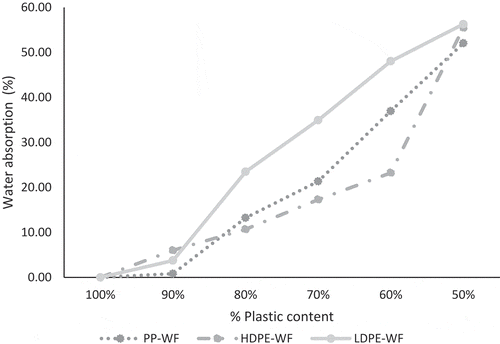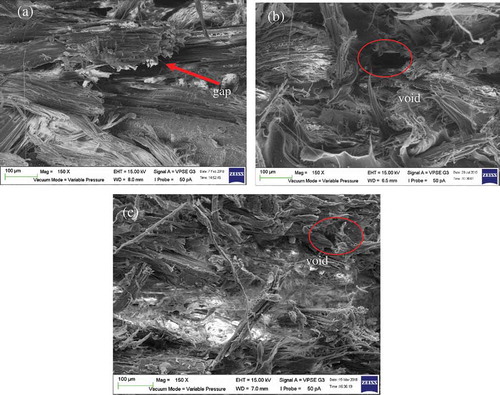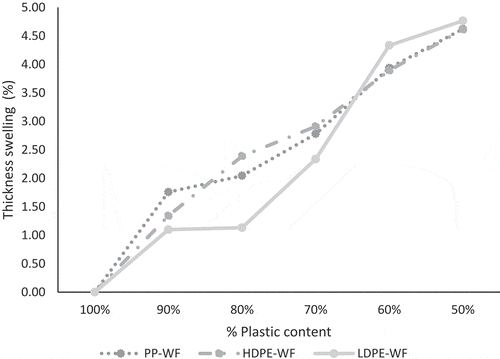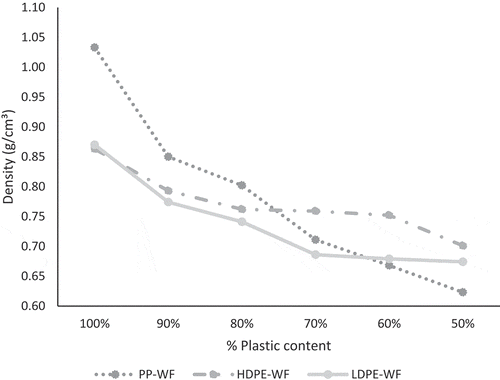 ?Mathematical formulae have been encoded as MathML and are displayed in this HTML version using MathJax in order to improve their display. Uncheck the box to turn MathJax off. This feature requires Javascript. Click on a formula to zoom.
?Mathematical formulae have been encoded as MathML and are displayed in this HTML version using MathJax in order to improve their display. Uncheck the box to turn MathJax off. This feature requires Javascript. Click on a formula to zoom.ABSTRACT
In this study, the term wood-plastic composite (WPC) refers to three different recycle codes of plastics combine with Acacia fiber namely polypropylene-wood fiber (PP-WF), high density polyethylene-wood fiber (HDPE-WF), and low density polyethylene-wood fiber (LDPE-WF). Each WPC was produced at different percentage combination (100:0, 90:10, 80:20, 70:30, 60:40, and 50:50). The relationship between plastic content and the physical properties (water absorption, thickness swelling, and density) of WPC were investigated. Water absorption and thickness swelling were evaluated after 15 days of water immersion. It was found that WPC of PP-WF, HDPE-WF and LDPE-WF had a significant difference at P ≤ 0.05 for water absorption, thickness swelling, and density. While water absorption and thickness swelling increased when the plastic content decreased. At combination of 50:50, WPC of PP-WF, HDPE-WF, and LDPE-WF showed range value between 52.03% and 56.27% of water absorption. While for thickness swelling at combination of 50:50 WPC of PP-WF showed 4.62%, HDPE-WF and LDPE-WF showed 4.61% and 4.77%, respectively. WPC of PP-WF, HDPE-WF, and LDPE-WF showed density 1.033 g/cm3, 0.862 g/cm3, and 0.870 g/cm3 respectively, at 100% plastic content. This finding revealed due to the present of hydroxyl group in wood fiber and some voids in WPC. The evidence of the poor interfacial bonding in WPC was analyzed using scanning electron microscope.
Introduction
Plastic waste is one of the major contributors to municipal solid waste not only in Malaysia but globally as well. It was estimated that in 2025, plastic waste generated around the world will increase by 9–13% [Citation1]. This kind of waste if not managed well will lead to environmental problem where some of the plastic waste ends up in the sea which will be harmful to aquatic life and some cause landfill problem.
In order to recover the excessive of plastic waste, recycling is one of the common methods in plastic waste management. Now, the term recycled plastic has become popular in recent studies. This is because recycled plastic could be a promising raw material source for wood-plastic composite (WPC). The advantages of using recycled plastic in producing WPC were in term of saving natural resource and become a proper way to dispose plastic waste.
Polypropylene (PP), High density polyethylene (HDPE) and Low density polyethylene (LDPE) are common recycled plastics that were used in WPC. These type of plastic can be identified with different recycle code, which contains the triangular-shaped recycling arrows that showed number 2 (HDPE), 4 (LDPE), and 5 (PP) [Citation2].
Since recycled plastics were collected from various sources, the result for physical properties were different for each type of plastic when combined with wood fiber in producing WPC. This is because they undergone different recycling conditions [Citation3]. Moreover, to produce WPC, melting point of recycled plastic must be considered where recycled plastics must melt below the degradation temperature of wood which is 200°C. The melting points for PP, HDPE, and LDPE are 170°C, 130°C, and 115°C, respectively.
Water absorption and thickness swelling are one of the criterions that affect the durability of the WPC. The amount of plastic content may increase the water absorption and thickness swelling of WPC. One of the reasons is because of the hydrophilic properties of wood fiber who tend to absorb water due to the present of hydroxyl group. This is supported by Khalil et al. [Citation4] which reveal that decreasing in plastic content increased the amount of water absorption and thickness swelling.
Besides, another reason caused the higher amount of water absorption and thickness swelling as the plastic content decrease is the present of voids in WPC, moreover, lack adhesion between plastic matrix and wood fiber is one of the factor water tend to be absorbed into WPC [Citation5]. In this study, the relationship between plastic content and the physical properties of WPC of PP-WF, HDPE-WF, and LDPE-WF at different combination (100:0, 90:10, 80:20, 70:30, 60:40, and 50:50) were investigated.
Materials and methods
Acacia wood fibers were used in the size of 7 µm to 212 µm. Recycled plastic materials of PP, HDPE, and LDPE were collected from domestic wastes. Before preparation of test pieces, wood fibers were dried in an oven at 105 ± 2°C for 24 h. Weight of different percentage combination of plastics and wood fibers were determined and were bagged based on their combination as shown in .
Table 1. Percentage combination of WPC of PP-WF, HDPE-WF, and LDPE-WF.
WPC was produced by combining the recycled plastics of PP, HDPE, and LDPE with wood fibers using a Hot-Press machine which was set to different temperature based on PP, HDPE, and LDPE melting point when pressing. First, recycled plastic of PP, HDPE, and LDPE chopped into particles. Next, wood fibers were manually mixed to recycled plastic by using a glass rode before pressed to another five minute. After that, WPC was formed and cut into small pellet shape before placed into a mold to be pressed again to get a test piece. Water absorption and thickness swelling test were carried out based on ASTM 570–58 [Citation6]. Fifteen test pieces for each combination of PP-WF, HDPE-WF, and LDPE-WF were selected. Water absorption (%) and thickness swelling (%) were calculated by using Equations 3.1 and 3.2:
Where M1 is the initial weight of test piece while M2 is the final weight of test piece.
Where T1 is the initial thickness of test piece while T2 is the final thickness of test piece.
Density of the test piece was measured according to Sommerhuber et al. [Citation7]. The test piece used for the density was similar to the test piece used in water absorption and thickness swelling test.
The statistical analysis was analyzed using SPSS software in conjunction with the analysis of variance and Post Hoc test was used to test the significant difference at p ≤ 0.05. The linear regression model was used to analyze the relationship between the plastic content and physical properties of WPC.
Results and discussion
The trend result of water absorption for WPC of PP-WF, HDPE-WF, and LDPE-WF was illustrated in . As can be seen, the water absorption for WPC of PP-WF, HDPE-WF, and LDPE-WF was increased with the decreasing of plastic content in each formulation (100:0, 90:10, 80:20, 70:30, 60:40, and 50:50).
Figure 1. Effect of plastic content on water absorption of wood-plastic composite of PP-WF, HDPE-WF, and LDPE-WF.

The finding suggested that water absorption affected by the nature phenomena of wood fiber which was hydrophilic. Wood fibers consist of hydroxyl group where hydrogen bonding was formed with occurrence of water. While decreasing in plastic content means that more wood fiber content, which resulted in higher water absorption [Citation8]. Recycled plastic acts as hydrophobic. This was proven by WPC of PP-WF, HDPE-WF, and LDPE-WF achieved 0% of water absorption at 100% plastic content. The high hydrophobic nature of PP, HDPE, and LDPE were due to their low polarity and low surface free energy [Citation3]. Besides, the reason for the increasing of water absorption was related to the poor interfacial bonding between the recycled plastic matrix and wood fibers. The poor interfacial bonding was due to the present of voids and gaps at the recycled plastic matrix and wood fiber interface can be shown in the SEM micrographs, . The present of voids and gaps caused water to be absorbed easily. Kord [Citation9] also found the same thing.
Figure 2. SEM micrographs of the wood-plastic composite at 150x magnification. (a) PP-WF at 50% plastic content (b) HDPE-WF at 50% plastic content (c) LDPE-WF at 50% plastic content.

Figure 3. Effect of plastic content on thickness swelling of wood-plastic composite of PP-WF, HDPE-WF, and LDPE-WF.

Figure 4. Effect of plastic content on density of wood-plastic composite of PP-WF, HDPE-WF, and LDPE-WF.

illustrated the thickness swelling for WPC of PP-WF, HDPE-WF, and LDPE-WF at different combination. It was observed that the thickness swelling for WPCs of PP-WF, HDPE-WF, and LDPE-WF increased as the plastic content decreased which were similar to result for water absorption.
The thickness swelling value for WPC of PP-WF, HDPE-WF, and LDPE-WF showed 0% respectively, at 100% plastic content. Then become increase to 4.62% (PP-WF), 4.61% (HDPE-WF), and 4.77% (LDPE-WF) at 50% plastic content. The increasing of thickness swelling was due by the absorption period which was 15 days. During this period, problem might come such as poor wetting of the wood fiber by the recycled plastic matrix where the interfacial bonding was not strong enough which resulted to more absorbency of water through voids. Same result also revealed by Najafi et al. [Citation5]. Other than that, uneven mixing may result to poor dispersion of wood fiber in recycled plastic matrix. This was also related to the size of the wood fibers. In this study, size of wood fiber used was at range between 7 ɥm to 212 ɥm and the wood fiber tend to form cluster when they were not totally covered by the recycled plastic matrix. The spot where more wood fiber gathered this area will easily experience micro-cracks and more gaps to occur due to the swelling of wood fiber as mentioned by Rahman et al. [Citation10].
Plastic content also affect the density of the WPC of PP-WF, HDPE-WF, and LDPE-WF. illustrated the density for WPC of PP-WF, HDPE-WF, and LDPE-WF at different combination.
Generally it can be observed that as the plastic content decreased, the density for WPC of PP-WF, HDPE-WF, and LDPE-WF also decreased. The density value for WPC of PP-WF showed 0.623 g/cm3, 0.701 g/cm3 and 0.674 g/cm3 for PP-WF, HDPE-WF, and LDPE-WF respectively, at 50% plastic content and 50% wood fiber. The combination of density of WPC of PP-WF, HDPE-WF, and LDPE-WF at combination 50:50 might probably cause by the larger geometry size of wood fiber which tends to have lower surface area thus lead to incomplete cover of recycled plastic matrix to wood fiber and more gaps and voids exist. Therefore, it was possible may cause the lower density of WPC.
Conclusion
The water absorption and thickness swelling of WPC of PP-WF, HDPE-WF, and LDPE-WF increased as the plastic content decreased. They showed more than 50% water absorption for water absorption while thickness swelling more than 4%. In the density aspect, decreasing plastic content on the WPC produced showed reduction in density to more than 50% from the original density of 100% plastic content composite.
Acknowledgments
The authors would like to appreciate with thanks the help from Faculty of Science and Natural Resources and Universiti Malaysia Sabah.
Disclosure statement
No potential conflict of interest was reported by the authors.
Additional information
Notes on contributors
Verra Gulitah
Verra Gulitah is a postgraduate student of Wood Fibre Technology and Industry course at Universiti Malaysia Sabah.
Kang Chiang Liew
Kang Chiang Liew is an Associate Professor in Faculty of Science and Natural Resources at Universiti Malaysia Sabah, with expertise in conventional and hybrid composites, pulp and paper.
References
- Wong SL, Ngadi N, Abdullah TAT, et al. Current state and future prospects of plastic waste as source of fuel: a review. Renewable and Sustainable Energy Reviews. 2015;50:1167–1180.
- Osswald TA. Understanding polymer processing. Ohio, USA: Hanser Publications; 2011.
- Najafi SK. Use of recycled plastics in wood plastic composites - A review. Waste Manage. 2013;33(9):1898–1905.
- Taylor P, Khalil HPSA, Rozman HD, et al. Polypropylene (PP)– Acacia mangiumcomposites: the effect of acetylation on mechanical and water absorption properties Mangium composites. Polym Plast Technol Eng (October 2014). 2007:37–41. DOI:10.1081/PPT-120004362.
- Najafi SK, Tajvidi M, Hamidina E. Effect of temperature, plastic type and virginity on the water uptake of sawdust/plastic composites. Holz Als Roh - Und Werkstoff. 2007;65(5):377–382.
- ASTM D570. Standard test method for water absorption of plastics 1. West Conshohocken, PA: ASTM International; 1998.
- Sommerhuber PF, Welling J, Krause A. Substitution potentials of recycled HDPE and wood particles from post-consumer packaging waste in wood-plastic composites. Waste Manage. 2015;46:76–85.
- Khalil HPSA, Sharifah Shahnaz SB, Ratnam MM. Recycle polypropylene (RPP) – Wood saw dust (WSD) composites – Part 1: the effect of different filler size and filler loading on mechanical and water absorption properties. J Reinf Plast Compos. 2006;25(12):1291–1303.
- Kord B. Effect of wood flour content on the hardness and water uptake of thermoplastic polymer composites. World Appl Sci J. 2011;12(9):1632–1634.
- Rahman K-S, Islam MN, Rahman MM, et al. Flat-pressed wood plastic composites from sawdust and recycled polyethylene terephthalate (PET): physical and mechanical properties. SpringerPlus. 2013;2:629.
